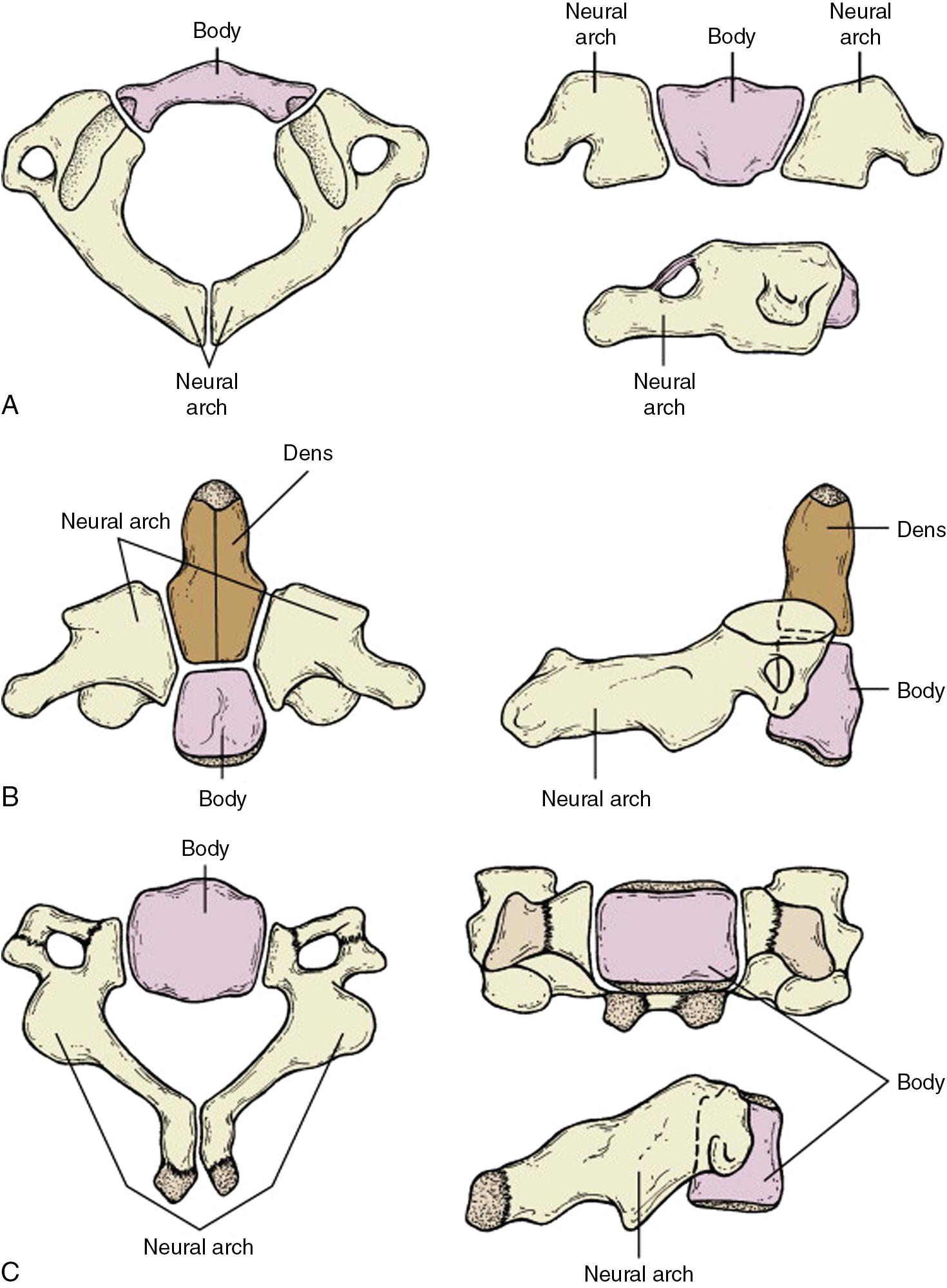Physical Address
304 North Cardinal St.
Dorchester Center, MA 02124
The Hox (homeobox) and Pax (paired box) genes regulate embryonic differentiation and segmentation of the developing vertebral column.
The atlas is formed from three primary ossification centers: the anterior arch and two neural arches. The anterior arch is not ossified at birth in most patients, which precludes use of the atlantodens interval (ADI) for diagnosis of C1–C2 instability during the first year of life. The neural arches develop into the lateral masses and fuse posteriorly around age 3–5 and fuse to the body anteriorly around age 7–9.
The axis is formed by five primary ossification centers: two neural arches or lateral masses, two halves of the odontoid process, and the body of C2. The body (centrum) is separated from the lateral masses by the neurocentral synchondroses and from the odontoid by the dentocentral synchondrosis. The body and neural arches fuse posteriorly by age 3 and anteriorly by age 6. The body generally fuses to the odontoid by age 6 but can fuse as late as age 11. A secondary ossification center at the tip of the odontoid, the os terminale, appears between ages 3 and 6 and fuses by age 12. Secondary centers of ossification can develop at the tips of the spinous process, transverse processes, and superior and inferior aspects of the vertebral body.
The spinal segments from C3 to C7 have a similar pattern of development as the thoracic and lumbar vertebrae and are comprised of a body (centrum) and paired neural arches. The neural arches fuse to the body between ages 2–8 years in the subaxial cervical region, 2–12 years in the lumbar region, and 2.5–18 years in the thoracic region. Secondary centers of ossification develop at the tips of the spinous process, transverse processes, and superior and inferior aspects of the vertebral body. Vertebral bodies grow in height by endochondral ossification, which occurs in a posterior to anterior direction and is responsible for the anterior wedge shape of the vertebra, which persists until approximately age 7 ( Fig. 36.1 ).

The immature cervical spine approaches adult size and shape around age 8.
Unique anatomic features of the immature cervical spine include hypermobility, hyperlaxity of ligamentous and capsular structures, presence of epiphyses and synchondroses, incomplete ossification, unique configuration of the vertebral bony elements (e.g., wedge-shaped vertebral bodies, horizontally oriented facet joints), and variable sagittal alignment.
Pediatric cervical disorders may be broadly classified by location (occiput-C2, C3–C7), clinical presentation (torticollis, instability, kyphosis, scoliosis), and etiology (e.g., congenital, developmental, acquired). Notable conditions that affect the occipitocervical junction and cervical region in pediatric patients include:
Basilar impression (invagination)
Arnold-Chiari malformation
Occipitocervical anomalies (e.g., occipitalization of C1)
Atlas (C1) anomalies (e.g., congenital unilateral absence of C1)
Odontoid (C2) anomalies (e.g., aplasia, hypoplasia, os odontoideum)
Occiput-C1 and C1–C2 instabilities
Atlantoaxial rotatory subluxation
Congenital muscular torticollis
Syndromic disorders (e.g., Down syndrome, Klippel-Feil syndrome)
Kyphotic disorders (e.g., iatrogenic, secondary to dysplastic or metabolic disorder)
Congenital scoliosis (failures of formation and/or segmentation)
Skeletal dysplasia (e.g., achondroplasia, Larsen syndrome)
Metabolic disorders (e.g., mucopolysaccharidoses)
Primary osseous or neural tumors
Infection
Inflammatory disorders (e.g., juvenile rheumatoid arthritis)
Trauma
Basilar impression (also termed basilar invagination) refers to the prolapse of the vertebral column into the skull base. Upward migration of C2 is associated with narrowing of the foramen magnum. There are two main types of basilar impression: primary and secondary.
Primary basilar impression is the most common type, and is associated with Chiari 1 malformation and syringohydromyelia, as well as vertebral defects including atlanto-occipital fusion, odontoid abnormalities, Klippel-Feil anomaly, hypoplasia of the atlas, and atlantoaxial instability. Vertebral artery abnormalities may also be present. The most significant clinical problems associated with congenital basilar impression are due to compression of the anterior or posterior brainstem. It is the most common congenital anomaly of the upper cervical spine.
Secondary basilar impression arises as the result of softening of osseous structures at the base of the skull. Diseases associated with secondary basilar impression include osteomalacia, rickets, Paget disease, osteogenesis imperfecta, Morquio syndrome, and rheumatoid arthritis.
Clinical manifestations are variable and wide-ranging and result from compression of the brainstem, cervical spinal cord, cranial nerves, cervical nerve roots, and vascular supply. Symptoms may include neck pain, myelopathy, central cord syndrome, and sensory changes. Brainstem compression and vertebrobasilar artery encroachment may manifest as sleep apnea or basilar migraine. Cranial nerve dysfunction may result in problems including hearing loss or dysphagia. Patients with congenital abnormalities may have a visibly shortened neck, painful cervical motion, torticollis, and asymmetry of the skull and face.
Become a Clinical Tree membership for Full access and enjoy Unlimited articles
If you are a member. Log in here